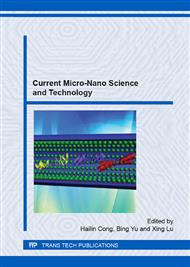p.67
p.72
p.77
p.83
p.87
p.92
p.97
p.103
p.111
Rapid, Simple and Selective Determination of 2,4,6-dinitrophenol Based on PtAg /Mesoporous SiO2 Nanocomposite Sensor with Electrochemical Detection
Abstract:
5-10nmPt-Ag nanoparticles were synthesized by Water thermal reduction, pluronic F127 and tetraethyl Orthosilicate (TEOS) have been used to synthesized mesoporous SiO2 template. Pt-Ag nanoparticles have been absorbed onto the surface of mesoporous SiO2. Finally, PtAg/mesoporous SiO2 nanocomposites have been modified on the surface of glass carbon electrode to prepared electrochemcial sensor which used to detect 2,4,6-dinitrophenol. In order to optimize experimental conditions, the synergistic reaction, buffer solution has been studied. The result show, when the potential at-0.404V, 2,4,6-dinitrophenol could be determined with a detection limit of 0.163μmol/L and linearity between 0.49-1667μmol/L . This sensor has high sensitivity, good reproducibility and stability.
Info:
Periodical:
Pages:
87-91
Citation:
Online since:
July 2015
Authors:
Price:
Сopyright:
© 2015 Trans Tech Publications Ltd. All Rights Reserved
Share:
Citation:


